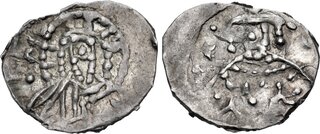| Classical Numismatic Group > Triton XXVII | Auction date: 9 January 2024 |
| Lot number: 971 Price realized: 19,000 USD (Approx. 17,402 EUR) Note: Prices do not include buyer's fees. | Show similar lots on CoinArchives Find similar lots in upcoming auctions on |
| Lot description: Constantine XI Palaeologus (Dragases). 1448-1453. AR Eighth Stavraton (13.5mm, 0.59 g, 12h). Constantinople mint. Facing bust of Christ Pantokrator, holding Gospels in both hands; [I]C - [XC], each with macron above, flanking head of Christ; sigla: • | • / Crowned facing bust of Constantine, wearing loros; •/K/• | •/C/• flanking. DOC 1789; Bendall, Coinage 135 (this coin); SB –. Toned. EF. Rare. From the James Fox Collection. Ex Classical Numismatic Group 40 (4 December 1996), lot 1964. Constantine XI, a member of the last Byzantine dynasty, the Palaeologan, was a heroic figure despite being fated to be the final Byzantine ruler. One of the younger sons of Emperor Manuel II, Constantine distinguished himself during the siege of Constantinople in 1422 during the last days of Manuel II's rule. After Manuel suffered a stroke and became incapable of governing, Constantine's older brother, future emperor John VIII, took the reins of the government on behalf of his father. However, John's first priority was to seek to rally support for the Byzantine state against the ascendant Ottomans. In pursuit of this objective, he embarked on a tour of Western Europe. In his stead, he left his younger brother Constantine as regent and granted him the title of despot. Constantine effectively administered what was left of the shrinking Byzantine State in his brother's absence, but John's quest to enlist western support for Byzantium was ultimately unsuccessful. Once John assumed the imperial mantle upon the death of Manuel II, Constantine was tasked with governing one of the few remaining possessions of the once-illustrious Byzantine Empire-the Depostate of Morea. Constantine again proved himself a capable ruler and administrator, using the limited resources he had at his disposal to recover Morea from the Franks who had occupied the Peloponnesos since the Fourth Crusade. Ultimately, Constantine's Morea encompassed the entire Pelponnesos and, along with Epirus, constituted the bulk of Byzantine possessions outside of Constantinople which was itself quickly shrinking into a city-state as more and more territory was lost to the Ottomans. When John died in 1448 without issue, Constantine was designated as his successor and called to assume the fateful position of emperor. Crowned at the citadel at Mystras, Constantine traveled from Morea to Constantinople in a hired Catalan galley-a succinct representation of how miserably Byzantine power had dwindled by the mid 15th century. The Byzantine fleet had been previously destroyed during the reign of John VI in a disastrous naval engagement in 1349 with the Genoese. All Constantine could do in his new station as emperor was prepare for the inevitable attack by the Ottomans. He worked to repair the city walls and recruit and muster as many soldiers as possible to mount his final defense of the city. As part of that effort, coins such as this rare example were minted to pay the mostly hired soldiers. The attack came in late May of 1453. Constantine himself manned the ramparts and fought valiantly during the city's final defense. He was ultimately killed upon the city walls and his corpse mutilated by the invaders. Thus ended the Byzantine Empire, an institution that lasted nearly a millennium and outlasted its parent Western Roman Empire by five centuries. Estimate: 7500 USD |  |



